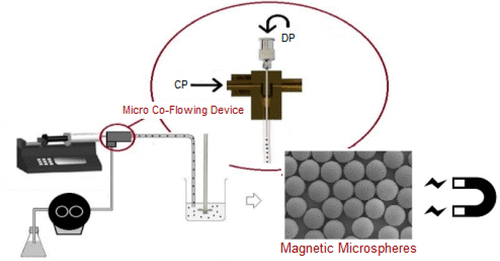当前位置:
X-MOL 学术
›
ACS Biomater. Sci. Eng.
›
论文详情
Our official English website, www.x-mol.net, welcomes your
feedback! (Note: you will need to create a separate account there.)
Development of a Coflowing Device for the Size-Controlled Preparation of Magnetic-Polymeric Microspheres as Embolization Agents in Magnetic Resonance Navigation Technology
ACS Biomaterials Science & Engineering ( IF 5.4 ) Pub Date : 2018-02-08 00:00:00 , DOI: 10.1021/acsbiomaterials.7b00839 Zeynab Nosrati 1 , Ning Li 2 , François Michaud 3 , Sahan Ranamukhaarachchi 1 , Stoyan Karagiozov 1 , Gilles Soulez 4 , Sylvain Martel 2 , Katayoun Saatchi 1 , Urs O. Häfeli 1
ACS Biomaterials Science & Engineering ( IF 5.4 ) Pub Date : 2018-02-08 00:00:00 , DOI: 10.1021/acsbiomaterials.7b00839 Zeynab Nosrati 1 , Ning Li 2 , François Michaud 3 , Sahan Ranamukhaarachchi 1 , Stoyan Karagiozov 1 , Gilles Soulez 4 , Sylvain Martel 2 , Katayoun Saatchi 1 , Urs O. Häfeli 1
Affiliation

|
Droplet microfluidics technology has recently been introduced to generate particles for many biomedical applications that include therapeutic embolizing agents in hepatic, uterine or bronchial arteries. Embolic agents are available in a variety of shapes and sizes that are adjusted according to the target vessel characteristics. Magnetic embolic agents can additionally be navigated to the target location (e.g., a tumor) through the blood system by applying an external magnetic field. This technology is termed Magnetic Resonance Navigation (MRN). Here we introduce a high throughput method to produce homogeneously sized magnetic microspheres (MMS) as blood vessel embolic agents for use in combination with MRN. The system for MMS production consists of a simple 3D printed micro coflowing device that is able to produce biocompatible, degradation rate controllable poly(lactic-co-glycolic acid) (PLGA) microspheres encasing magnetic nanoparticles. Axisymmetric flow is obtained with a central needle injecting the dispersed phase surrounded by a continuous phase and leads to the formation of size-controlled droplets that turn into homogeneously sized MMS linearly dependent on the inner needle diameter. MMS morphology, mean particle size and size distribution were quantified from SEM images. Magnetic performance of MMS was investigated using a vibrating sample magnetometer. MMS were nontoxic toward HUVEC (human umbilical vein endothelial cells) and HEK293 (human embryonic kidney) cells. The presented micro coflowing method allows for the reliable production of large MMS sized 130–700 μm with narrow size distribution (CV < 7%) and magnetic properties useful for MRN.
中文翻译:

磁共振导航技术中用于栓塞剂的磁聚合微球尺寸控制制备的同流装置的开发
最近已引入液滴微流控技术,以产生用于许多生物医学应用的颗粒,这些颗粒包括肝,子宫或支气管动脉中的治疗栓塞剂。栓塞剂有多种形状和大小,可根据目标血管的特性进行调整。磁性栓塞剂可以另外通过施加外部磁场通过血液系统导航到目标位置(例如,肿瘤)。这项技术称为磁共振导航(MRN)。在这里,我们介绍一种高通量方法,以生产尺寸均匀的磁性微球(MMS)作为与MRN结合使用的血管栓塞剂。MMS生产系统由一个简单的3D打印微同流设备组成,该设备能够产生生物相容性,共-glycolic乙酸)(PLGA)微球包封的磁性纳米颗粒。用中心针头注射被连续相包围的分散相可得到轴对称流动,并导致形成受尺寸控制的液滴,这些液滴变成线性分布的均匀MMS(取决于内部针头直径)。MMS形态,平均粒度和粒度分布由SEM图像定量。使用振动样品磁力计研究了MMS的磁性能。MMS对HUVEC(人脐静脉内皮细胞)和HEK293(人胚肾)细胞无毒。提出的微同流方法可以可靠地生产130-700μm的大型MMS,具有狭窄的尺寸分布(CV <7%)和对MRN有用的磁性能。
更新日期:2018-02-08
中文翻译:

磁共振导航技术中用于栓塞剂的磁聚合微球尺寸控制制备的同流装置的开发
最近已引入液滴微流控技术,以产生用于许多生物医学应用的颗粒,这些颗粒包括肝,子宫或支气管动脉中的治疗栓塞剂。栓塞剂有多种形状和大小,可根据目标血管的特性进行调整。磁性栓塞剂可以另外通过施加外部磁场通过血液系统导航到目标位置(例如,肿瘤)。这项技术称为磁共振导航(MRN)。在这里,我们介绍一种高通量方法,以生产尺寸均匀的磁性微球(MMS)作为与MRN结合使用的血管栓塞剂。MMS生产系统由一个简单的3D打印微同流设备组成,该设备能够产生生物相容性,共-glycolic乙酸)(PLGA)微球包封的磁性纳米颗粒。用中心针头注射被连续相包围的分散相可得到轴对称流动,并导致形成受尺寸控制的液滴,这些液滴变成线性分布的均匀MMS(取决于内部针头直径)。MMS形态,平均粒度和粒度分布由SEM图像定量。使用振动样品磁力计研究了MMS的磁性能。MMS对HUVEC(人脐静脉内皮细胞)和HEK293(人胚肾)细胞无毒。提出的微同流方法可以可靠地生产130-700μm的大型MMS,具有狭窄的尺寸分布(CV <7%)和对MRN有用的磁性能。











































 京公网安备 11010802027423号
京公网安备 11010802027423号